Leverage Points: Places to Intervene in a System
by Donella Meadows
Made into a thread for QTing, by me! https://abs.twimg.com/emoji/v2/... draggable="false" alt="🧵" title="Thread" aria-label="Emoji: Thread">
https://abs.twimg.com/emoji/v2/... draggable="false" alt="🧵" title="Thread" aria-label="Emoji: Thread"> https://abs.twimg.com/emoji/v2/... draggable="false" alt="👇" title="Down pointing backhand index" aria-label="Emoji: Down pointing backhand index">
https://abs.twimg.com/emoji/v2/... draggable="false" alt="👇" title="Down pointing backhand index" aria-label="Emoji: Down pointing backhand index">
by Donella Meadows
Made into a thread for QTing, by me!
Some Systems Theory terminology:
the state of the system is some key stock, eg "water in damn", "money in bank", "trust in officials"
inflows increase stock, outflows decrease
inflow > out https://abs.twimg.com/emoji/v2/... draggable="false" alt="↔" title="Left right arrow" aria-label="Emoji: Left right arrow"> stock goes up, & vv
https://abs.twimg.com/emoji/v2/... draggable="false" alt="↔" title="Left right arrow" aria-label="Emoji: Left right arrow"> stock goes up, & vv
an agent may compare perceived state to goal & adjust accordingly
the state of the system is some key stock, eg "water in damn", "money in bank", "trust in officials"
inflows increase stock, outflows decrease
inflow > out
an agent may compare perceived state to goal & adjust accordingly
For example, imagine filling a bathtub with water: inflow from the faucet, outflow through the drain.
Turning the faucet fully open doesn& #39;t immediately fill the tub—it takes time for flows to accumulate.
You control the inflow & outflow to make the water level match your goal.
Turning the faucet fully open doesn& #39;t immediately fill the tub—it takes time for flows to accumulate.
You control the inflow & outflow to make the water level match your goal.
Of course, in reality there& #39;s also a temperature variable, with a delay to get hot water from the basement, etc
and this applies to other systems, from global climate feedback loops to $ to perceptual systems in your own brain
okay: enough systems theory, time for the list!
and this applies to other systems, from global climate feedback loops to $ to perceptual systems in your own brain
okay: enough systems theory, time for the list!
PLACES TO INTERVENE IN A SYSTEM
(in increasing order of effectiveness)
This list evolved from a flash of insight D.M. had during a meeting. This version& #39;s from ~1999—she indicated it& #39;s a work-in-progress & intended to invite co-exploration. Maybe twitter& #39;s the medium for that!
(in increasing order of effectiveness)
This list evolved from a flash of insight D.M. had during a meeting. This version& #39;s from ~1999—she indicated it& #39;s a work-in-progress & intended to invite co-exploration. Maybe twitter& #39;s the medium for that!
Leverage Point 12: constants, parameters, numbers
eg
- tax rates
- wages, prices
- pollution limits
- funding availability
- which person is in a particular role
Parameters are only high-leverage to the extent they affect other items on this list, like loop gain or goals.
eg
- tax rates
- wages, prices
- pollution limits
- funding availability
- which person is in a particular role
Parameters are only high-leverage to the extent they affect other items on this list, like loop gain or goals.
Leverage Point 11: sizes of buffers & other stabilizing stocks, relative to their flows
eg difference between
 https://abs.twimg.com/emoji/v2/... draggable="false" alt="🔵" title="Blue circle" aria-label="Emoji: Blue circle"> a lake (mostly buffer)
https://abs.twimg.com/emoji/v2/... draggable="false" alt="🔵" title="Blue circle" aria-label="Emoji: Blue circle"> a lake (mostly buffer)
 https://abs.twimg.com/emoji/v2/... draggable="false" alt="↩️" title="Leftwards arrow with hook" aria-label="Emoji: Leftwards arrow with hook"> a river (mostly flow)
https://abs.twimg.com/emoji/v2/... draggable="false" alt="↩️" title="Leftwards arrow with hook" aria-label="Emoji: Leftwards arrow with hook"> a river (mostly flow)
More buffer usually means more stability & margin-for-error, but can be costly & less agile. Often hard to change.
eg difference between
More buffer usually means more stability & margin-for-error, but can be costly & less agile. Often hard to change.
Leverage Point 10: structure of material stocks and flows
eg Hungarian road system send all traffic thru Budapest—that creates a lot of air pollution & commuting delays that are not easily fixed by https://abs.twimg.com/emoji/v2/... draggable="false" alt="🚥" title="Horizontal traffic light" aria-label="Emoji: Horizontal traffic light">,
https://abs.twimg.com/emoji/v2/... draggable="false" alt="🚥" title="Horizontal traffic light" aria-label="Emoji: Horizontal traffic light">,  https://abs.twimg.com/emoji/v2/... draggable="false" alt="⚠️" title="Warning sign" aria-label="Emoji: Warning sign">, speed limits
https://abs.twimg.com/emoji/v2/... draggable="false" alt="⚠️" title="Warning sign" aria-label="Emoji: Warning sign">, speed limits
Low leverage to rebuild; higher to design well in 1st place
eg Hungarian road system send all traffic thru Budapest—that creates a lot of air pollution & commuting delays that are not easily fixed by
Low leverage to rebuild; higher to design well in 1st place
Leverage Point 9: lengths of delays
Delay can be in perception or execution
Often issue is too much delay (overshooting oscillations, eg shower temp https://abs.twimg.com/emoji/v2/... draggable="false" alt="🥶" title="Cold face" aria-label="Emoji: Cold face">
https://abs.twimg.com/emoji/v2/... draggable="false" alt="🥶" title="Cold face" aria-label="Emoji: Cold face"> https://abs.twimg.com/emoji/v2/... draggable="false" alt="🥵" title="Hot face" aria-label="Emoji: Hot face">
https://abs.twimg.com/emoji/v2/... draggable="false" alt="🥵" title="Hot face" aria-label="Emoji: Hot face"> https://abs.twimg.com/emoji/v2/... draggable="false" alt="🚿" title="Shower" aria-label="Emoji: Shower">) but too little = overreaction (eg
https://abs.twimg.com/emoji/v2/... draggable="false" alt="🚿" title="Shower" aria-label="Emoji: Shower">) but too little = overreaction (eg  https://abs.twimg.com/emoji/v2/... draggable="false" alt="👻" title="Ghost" aria-label="Emoji: Ghost">
https://abs.twimg.com/emoji/v2/... draggable="false" alt="👻" title="Ghost" aria-label="Emoji: Ghost"> https://abs.twimg.com/emoji/v2/... draggable="false" alt="➡️" title="Rightwards arrow" aria-label="Emoji: Rightwards arrow">
https://abs.twimg.com/emoji/v2/... draggable="false" alt="➡️" title="Rightwards arrow" aria-label="Emoji: Rightwards arrow"> https://abs.twimg.com/emoji/v2/... draggable="false" alt="😱" title="Face screaming in fear" aria-label="Emoji: Face screaming in fear">)
https://abs.twimg.com/emoji/v2/... draggable="false" alt="😱" title="Face screaming in fear" aria-label="Emoji: Face screaming in fear">)
Delays are RELATIVE to rate of system change—often easier to modify the latter
Delay can be in perception or execution
Often issue is too much delay (overshooting oscillations, eg shower temp
Delays are RELATIVE to rate of system change—often easier to modify the latter
Leverage Point 8: strength of negative feedback loops
these self-correcting loops maintain equilibrium (dynamic or status)
some usually-inactive but vital (eg fuse)
RELATIVE to disturbance size: eg thermostat+furnace can handle a cold winter day but not if all windows opened
these self-correcting loops maintain equilibrium (dynamic or status)
some usually-inactive but vital (eg fuse)
RELATIVE to disturbance size: eg thermostat+furnace can handle a cold winter day but not if all windows opened
Leverage Point 7: gain around driving positive feedback loops
these self-reinforcing loops drive exponential growth
eg more sick people, more transmission of virus:
WAY costlier to fight each instance than reduce gain #StayAtHome https://abs.twimg.com/hashflags... draggable="false" alt="">
https://abs.twimg.com/hashflags... draggable="false" alt="">
eventually will hit a limit (sometimes https://abs.twimg.com/emoji/v2/... draggable="false" alt="💥" title="Collision symbol" aria-label="Emoji: Collision symbol">)
https://abs.twimg.com/emoji/v2/... draggable="false" alt="💥" title="Collision symbol" aria-label="Emoji: Collision symbol">)
these self-reinforcing loops drive exponential growth
eg more sick people, more transmission of virus:
WAY costlier to fight each instance than reduce gain #StayAtHome
eventually will hit a limit (sometimes
Leverage Point 6: structure of information flows (who does & does not have access to information)
usually the leverage point here is in restoring the flow of information that has been blocked to avoid accountability
eg companies may pollute less if required to publish emissions
usually the leverage point here is in restoring the flow of information that has been blocked to avoid accountability
eg companies may pollute less if required to publish emissions
Leverage Point 5: the rules of the system (eg incentives, punishments, constraints)
All previous leverage points are subject to the rules of the context they& #39;re in. The real incentives: de facto, not de jure.
> "Suppose a class got graded as a group, instead of as individuals"
All previous leverage points are subject to the rules of the context they& #39;re in. The real incentives: de facto, not de jure.
> "Suppose a class got graded as a group, instead of as individuals"
Leverage Point 4: the power to add, change, evolve, or self-organize system structure
eg
- evolution
- technology
- cultural change
More self-organization = more resilience & creativity & learning, but harder to externally control so often resisted (in govt, corp, edu, family).
eg
- evolution
- technology
- cultural change
More self-organization = more resilience & creativity & learning, but harder to externally control so often resisted (in govt, corp, edu, family).
Leverage Point 3: the goals of the system.
All points so far are subject to "what is system trying to do?"
Often "control"/"power-over", which undermines self-organization, as above.
One of the ways people impact systems (govt, corp) is by aligning people around new goals.
All points so far are subject to "what is system trying to do?"
Often "control"/"power-over", which undermines self-organization, as above.
One of the ways people impact systems (govt, corp) is by aligning people around new goals.
Leverage Point 2: the mindset/paradigm out of which the system arises
The meaning-context in which to debate goals, rules., is in the shared ideas in the minds of society, unstated because everyone already knows them.
Hard to change but (unlike https://abs.twimg.com/emoji/v2/... draggable="false" alt="🚉" title="Station" aria-label="Emoji: Station">
https://abs.twimg.com/emoji/v2/... draggable="false" alt="🚉" title="Station" aria-label="Emoji: Station"> https://abs.twimg.com/emoji/v2/... draggable="false" alt="🏭" title="Factory" aria-label="Emoji: Factory">
https://abs.twimg.com/emoji/v2/... draggable="false" alt="🏭" title="Factory" aria-label="Emoji: Factory"> https://abs.twimg.com/emoji/v2/... draggable="false" alt="🏦" title="Bank" aria-label="Emoji: Bank">) can flip in an instant
https://abs.twimg.com/emoji/v2/... draggable="false" alt="🏦" title="Bank" aria-label="Emoji: Bank">) can flip in an instant  https://abs.twimg.com/emoji/v2/... draggable="false" alt="👁️" title="Eye" aria-label="Emoji: Eye">
https://abs.twimg.com/emoji/v2/... draggable="false" alt="👁️" title="Eye" aria-label="Emoji: Eye">
The meaning-context in which to debate goals, rules., is in the shared ideas in the minds of society, unstated because everyone already knows them.
Hard to change but (unlike
Leverage Point 1: the power to transcend paradigms
to realize that NO paradigm is “true”
to “get” at a gut level the paradigm that there are paradigms, & see that that itself is a paradigm, and to regard that whole realization as devastatingly funny
to let go into Not Knowing
to realize that NO paradigm is “true”
to “get” at a gut level the paradigm that there are paradigms, & see that that itself is a paradigm, and to regard that whole realization as devastatingly funny
to let go into Not Knowing
D.M. concludes ~
> so much has to be said to qualify this list [this goes 10× for this tweetstorm]
> It is tentative & its order is slithery… exceptions to every item can move it up or down"
> The higher the leverage point, the more the system will resist changing it
> so much has to be said to qualify this list [this goes 10× for this tweetstorm]
> It is tentative & its order is slithery… exceptions to every item can move it up or down"
> The higher the leverage point, the more the system will resist changing it
Paradoxically,
> In the end, it seems that mastery has less to do with pushing leverage points than it does with strategically, profoundly, madly letting go.
Full essay: http://donellameadows.org/archives/leverage-points-places-to-intervene-in-a-system/">https://donellameadows.org/archives/...
> In the end, it seems that mastery has less to do with pushing leverage points than it does with strategically, profoundly, madly letting go.
Full essay: http://donellameadows.org/archives/leverage-points-places-to-intervene-in-a-system/">https://donellameadows.org/archives/...

 Read on Twitter
Read on Twitter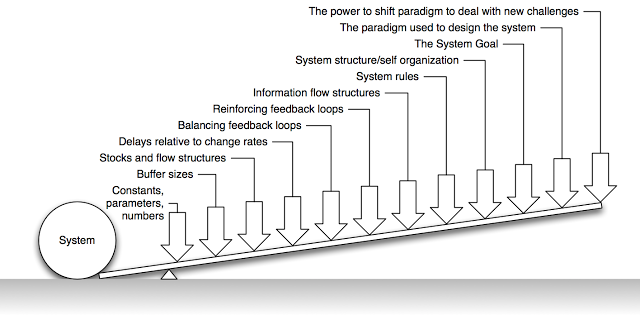 https://abs.twimg.com/emoji/v2/... draggable="false" alt="👇" title="Down pointing backhand index" aria-label="Emoji: Down pointing backhand index">" title="Leverage Points: Places to Intervene in a Systemby Donella MeadowsMade into a thread for QTing, by me! https://abs.twimg.com/emoji/v2/... draggable="false" alt="🧵" title="Thread" aria-label="Emoji: Thread">https://abs.twimg.com/emoji/v2/... draggable="false" alt="👇" title="Down pointing backhand index" aria-label="Emoji: Down pointing backhand index">" class="img-responsive" style="max-width:100%;"/>
https://abs.twimg.com/emoji/v2/... draggable="false" alt="👇" title="Down pointing backhand index" aria-label="Emoji: Down pointing backhand index">" title="Leverage Points: Places to Intervene in a Systemby Donella MeadowsMade into a thread for QTing, by me! https://abs.twimg.com/emoji/v2/... draggable="false" alt="🧵" title="Thread" aria-label="Emoji: Thread">https://abs.twimg.com/emoji/v2/... draggable="false" alt="👇" title="Down pointing backhand index" aria-label="Emoji: Down pointing backhand index">" class="img-responsive" style="max-width:100%;"/>
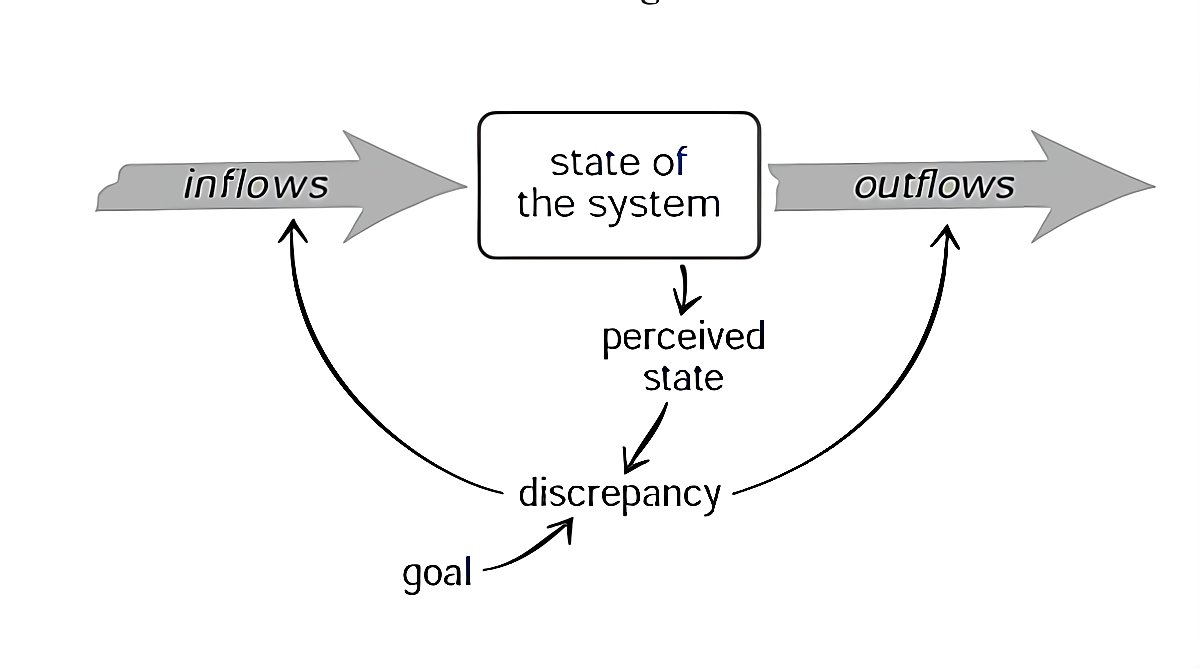 stock goes up, & vvan agent may compare perceived state to goal & adjust accordingly" title="Some Systems Theory terminology:the state of the system is some key stock, eg "water in damn", "money in bank", "trust in officials"inflows increase stock, outflows decreaseinflow > out https://abs.twimg.com/emoji/v2/... draggable="false" alt="↔" title="Left right arrow" aria-label="Emoji: Left right arrow"> stock goes up, & vvan agent may compare perceived state to goal & adjust accordingly" class="img-responsive" style="max-width:100%;"/>
stock goes up, & vvan agent may compare perceived state to goal & adjust accordingly" title="Some Systems Theory terminology:the state of the system is some key stock, eg "water in damn", "money in bank", "trust in officials"inflows increase stock, outflows decreaseinflow > out https://abs.twimg.com/emoji/v2/... draggable="false" alt="↔" title="Left right arrow" aria-label="Emoji: Left right arrow"> stock goes up, & vvan agent may compare perceived state to goal & adjust accordingly" class="img-responsive" style="max-width:100%;"/>
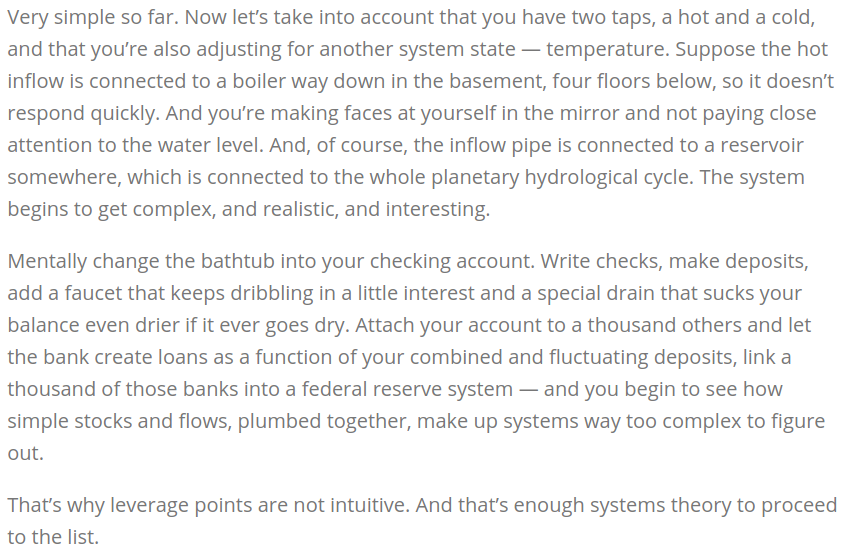
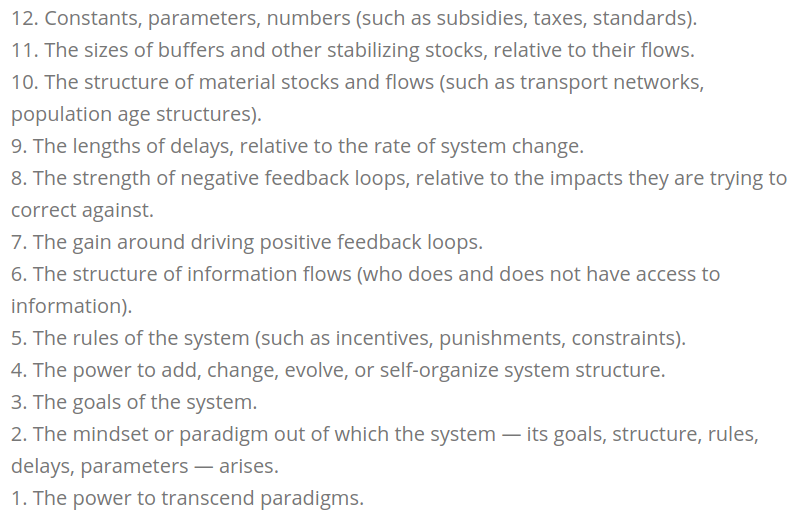

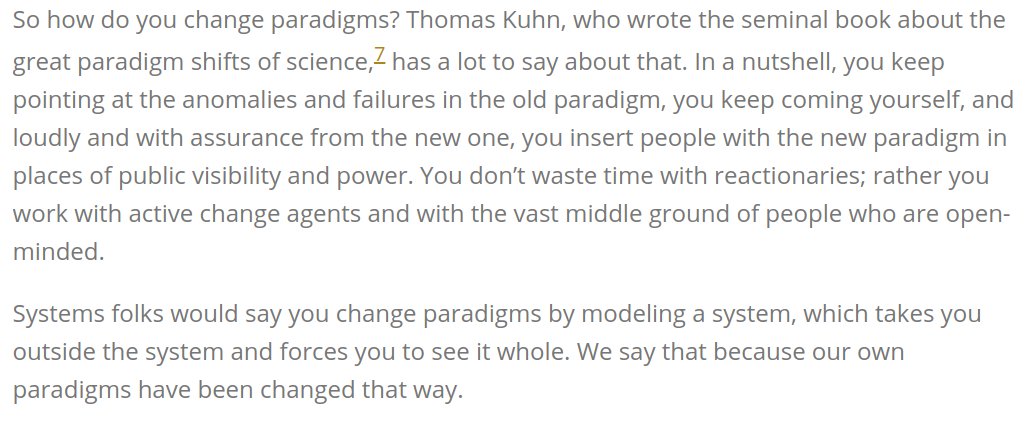 https://abs.twimg.com/emoji/v2/... draggable="false" alt="🏭" title="Factory" aria-label="Emoji: Factory">https://abs.twimg.com/emoji/v2/... draggable="false" alt="🏦" title="Bank" aria-label="Emoji: Bank">) can flip in an instant https://abs.twimg.com/emoji/v2/... draggable="false" alt="👁️" title="Eye" aria-label="Emoji: Eye">" title="Leverage Point 2: the mindset/paradigm out of which the system arisesThe meaning-context in which to debate goals, rules., is in the shared ideas in the minds of society, unstated because everyone already knows them.Hard to change but (unlike https://abs.twimg.com/emoji/v2/... draggable="false" alt="🚉" title="Station" aria-label="Emoji: Station">https://abs.twimg.com/emoji/v2/... draggable="false" alt="🏭" title="Factory" aria-label="Emoji: Factory">https://abs.twimg.com/emoji/v2/... draggable="false" alt="🏦" title="Bank" aria-label="Emoji: Bank">) can flip in an instant https://abs.twimg.com/emoji/v2/... draggable="false" alt="👁️" title="Eye" aria-label="Emoji: Eye">" class="img-responsive" style="max-width:100%;"/>
https://abs.twimg.com/emoji/v2/... draggable="false" alt="🏭" title="Factory" aria-label="Emoji: Factory">https://abs.twimg.com/emoji/v2/... draggable="false" alt="🏦" title="Bank" aria-label="Emoji: Bank">) can flip in an instant https://abs.twimg.com/emoji/v2/... draggable="false" alt="👁️" title="Eye" aria-label="Emoji: Eye">" title="Leverage Point 2: the mindset/paradigm out of which the system arisesThe meaning-context in which to debate goals, rules., is in the shared ideas in the minds of society, unstated because everyone already knows them.Hard to change but (unlike https://abs.twimg.com/emoji/v2/... draggable="false" alt="🚉" title="Station" aria-label="Emoji: Station">https://abs.twimg.com/emoji/v2/... draggable="false" alt="🏭" title="Factory" aria-label="Emoji: Factory">https://abs.twimg.com/emoji/v2/... draggable="false" alt="🏦" title="Bank" aria-label="Emoji: Bank">) can flip in an instant https://abs.twimg.com/emoji/v2/... draggable="false" alt="👁️" title="Eye" aria-label="Emoji: Eye">" class="img-responsive" style="max-width:100%;"/>


